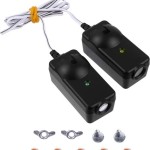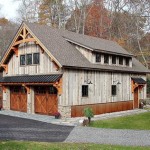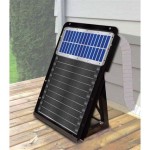Cooling a Garage with No Windows: Effective Strategies for Temperature Control
Garages, particularly those lacking windows, often become unbearably hot during warmer months. This excess heat can damage stored items, make working in the garage uncomfortable, and even contribute to higher energy bills for the adjacent house due to heat transfer. Managing the temperature within a windowless garage requires a multifaceted approach that considers ventilation, insulation, and alternative cooling methods.
The absence of windows presents a unique challenge to garage cooling. Natural ventilation, a common and cost-effective cooling strategy, is largely unavailable. Therefore, alternative methods must be employed to facilitate air circulation and temperature reduction. These methods range from simple upgrades to more complex installations, each with varying levels of effectiveness and cost.
Addressing the Lack of Natural Ventilation
Natural ventilation relies on the movement of air through openings such as windows and doors. Without these openings, air stagnates, trapping heat and humidity. To compensate for this deficiency, mechanical ventilation systems become crucial. These systems actively draw fresh air into the garage and expel hot, stale air, creating a continuous airflow that helps to regulate temperature.
One common solution is the installation of exhaust fans. These fans are typically mounted high on a wall or in the ceiling, where they can effectively draw out rising hot air. The size and quantity of exhaust fans needed will depend on the garage's dimensions and the severity of the heat buildup. It is important to select a fan with sufficient CFM (cubic feet per minute) rating to adequately ventilate the space. A general rule of thumb is to aim for at least six air changes per hour.
To maximize the effectiveness of exhaust fans, it is necessary to provide an intake point for fresh air. If the garage has a door leading to the outside, this can serve as a natural intake. However, if the garage is completely sealed, a passive air intake vent should be installed on the opposite side of the garage from the exhaust fan. This vent allows cooler, outside air to be drawn in as the exhaust fan removes the hot air, creating a continuous airflow loop.
Another option is to install a whole-house fan, which, while typically used for residential cooling, can be adapted for garage use. These fans are usually mounted in the attic and draw air from the lower levels of the house, including the garage, and expel it into the attic. While effective, this method requires careful consideration regarding the garage's connection to the rest of the house, as it can impact the overall home's air pressure and ventilation.
Improving Insulation and Reducing Heat Gain
Insulation plays a significant role in temperature control by reducing the transfer of heat. A well-insulated garage can minimize the amount of heat that enters from the outside during hot weather and prevent heat loss during cooler weather. Improving insulation in a windowless garage is particularly important because there is limited opportunity for heat to escape naturally.
The primary areas to focus on for insulation are the walls, ceiling, and garage door. Walls can be insulated with fiberglass batts, rigid foam boards, or spray foam insulation. Fiberglass batts are a cost-effective option, but they can be difficult to install properly in tight spaces and may require a vapor barrier to prevent moisture buildup. Rigid foam boards offer better insulation value and are easier to handle, but they can be more expensive. Spray foam insulation provides the best insulation value and seals air leaks, but it is the most expensive option and requires professional installation.
The garage ceiling is particularly important to insulate, as heat rises. The same insulation materials used for walls can be used for the ceiling. If the garage has an attic above it, insulating the attic floor can further reduce heat transfer. Installing a radiant barrier on the underside of the roof can also help to reflect heat away from the garage.
The garage door is often a major source of heat gain. Uninsulated garage doors can get extremely hot in direct sunlight, radiating heat into the garage. Replacing an uninsulated garage door with an insulated model can significantly reduce heat transfer. Alternatively, insulation kits are available that can be applied to existing garage doors. These kits typically consist of rigid foam boards that are cut to fit the door panels and attached with adhesive.
In addition to insulating the major surfaces, it is important to seal any air leaks around doors, windows (if any), and other openings. Weatherstripping can be used to seal gaps around doors and windows, and caulk can be used to seal cracks and seams in the walls and ceiling. Sealing air leaks prevents hot air from entering the garage and helps to maintain a consistent temperature.
Alternative Cooling Methods and Strategies
While ventilation and insulation are essential for cooling a garage, alternative cooling methods can provide additional temperature control. These methods range from portable solutions to more permanent installations, each with its own advantages and disadvantages.
Portable evaporative coolers, also known as swamp coolers, are a popular option for cooling garages. These coolers work by evaporating water, which absorbs heat from the air and lowers the temperature. Evaporative coolers are most effective in dry climates, where the air has a low humidity level. In humid climates, they are less effective because the air is already saturated with moisture. Evaporative coolers require a water source and regular maintenance to prevent mineral buildup and bacterial growth.
Portable air conditioners are another option for cooling garages. These units work by circulating refrigerant, which absorbs heat from the air and expels it outside. Portable air conditioners are more effective than evaporative coolers in humid climates, but they are also more expensive and require venting to the outside. The venting can be done through a window or a wall. Portable air conditioners can be noisy and consume a significant amount of electricity.
Ceiling fans can also help to improve air circulation and create a cooling effect. Ceiling fans do not actually cool the air, but they circulate it, which helps to evaporate sweat from the skin and make the garage feel cooler. Ceiling fans are relatively inexpensive and easy to install. They consume very little electricity and can be used in conjunction with other cooling methods to enhance their effectiveness.
Strategic use of shading can also reduce heat gain. If the garage door faces the sun, consider planting trees or installing awnings to provide shade. Shade reduces the amount of direct sunlight that hits the garage door, which in turn reduces the amount of heat that is radiated into the garage. Using reflective window film (if any windows exist) can also help to reduce heat gain. The film reflects sunlight away from the windows, preventing it from entering the garage.
Furthermore, managing activities that generate heat inside the garage can contribute to temperature control. Avoid using power tools or other heat-generating equipment during the hottest part of the day. If possible, schedule these activities for the early morning or late evening, when the temperature is cooler. Storing heat-sensitive items in a cooler location can also prevent them from being damaged by the heat.
Lastly, consider painting the garage door and exterior walls a lighter color. Dark colors absorb more heat than light colors, so painting the garage a lighter color can help to reflect sunlight and reduce heat gain. This is a simple and inexpensive way to improve the garage's cooling performance.
By implementing a combination of these strategies, it is possible to effectively cool a garage with no windows and create a more comfortable and usable space.

How To Cool A Garage With No Windows Alternative Energy Llc

How To Cool A Garage With Or No Windows

How To Cool A Garage With No Windows Tips For Cooler Space

How To Cool A Garage 10 Best Ways Cielo Breez

How To Air Condition Your Garage Cheap Diy

How To Cool A Garage With Or No Windows Youtube

How To Cool A Garage With No Windows Tips For Cooler Space

11 Garage Cooling Ideas Options Solutions

How To Keep A Garage Cool In Arizona Florida Ae

Air Conditioning How Can I Condition A Garage Without Modifying It Home Improvement Stack Exchange
See Also








